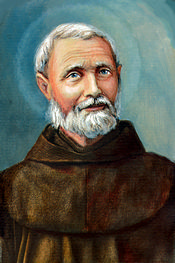Lives of the Saints
Our Models and Protectors
Spiritual Bouquet:
August 4

Janssoone of Ghyvelde
O.D.M. pinxit
Blessed Father Frederick
Janssoone of Ghyvelde
Franciscan Missionary to Four Continents
(1838-1916)
Born in 1838 in Ghyvelde, France, of a Flemish family, Father Frederick Janssoone was the thirteenth and last child. From early youth he aspired to consecrate his life to God, but his mother's widowhood and subsequent long illness delayed his plans. He took employment in nearby Hazebrouck, selling fabrics. When he was 25 years old, his pious mother died, and in the same year her three youngest sons all decided, independently of one another, to enter religion. Frederick decided upon the Seraphic Order, whose ideals corresponded exactly with his own. Strict poverty, sustaining an apostolate founded on penance and prayer, would always characterize his religious life. He entered the Franciscan novitiate of Amiens in 1864, and was ordained a priest in 1870. He served as military chaplain during the brief Franco-Prussian war, facing undaunted the contagion of a triple epidemic.
In October 1871, with another priest and four Franciscan Brothers, Father Frederick was named to found a convent of the Order in Bordeaux. He collaborated with the founder of a magazine, writing articles for the Revue Franciscaine; he became local Guardian in Bordeaux in 1873, when he was 35 years old. In 1874 he was relieved of the responsibility of Superior to preach retreats; he also began to found fraternities of the Third Order. In 1876, he had a strong desire to labor for his Lord in the Holy Land; his request was granted, and he left for Palestine in 1877 with a brother Franciscan. During his first year in the Orient, he preached retreats for religious communities in both Syria and Egypt, returning to Jerusalem in 1878, when he was elected to serve as Custodial Vicar. There he could remain close to the very place where our Saviour's Redemption was effected — the Basilica which conserves within it the site of Calvary and the Holy Sepulchre itself. He accompanied pilgrimages to preside the prayer and act as guide, and he preached on many formal occasions; he reinstated the Way of the Cross along the path Our Lord took to Calvary. He took charge of building activities for the restoration of churches and preparation of much-needed lodgings for pilgrims. Father Frederick's humility and Franciscan charity brought about harmony among the various factions of the Holy City.
Father Frederick came to Canada in 1881 to beg for financial aid to the Custody, which had begun renovation of the antique Basilica of Bethlehem. He brought with him relics of the Holy Land, and these, when venerated or applied to afflicted members of infirm persons, began to effect miracles in Quebec City. The people called the ardent priest a miracle-worker, whereas he ascribed the miracles to God's love, the efficacy of Our Saviour's redemptive death on Calvary, and the faith of the people. When he was recalled to the Holy Land after only eight months in the Province, all the Canadians who knew him desired his return.
In the summer of that year he came to Trois Rivieres, Quebec, because Monsignor Louis Lafleche, its fervent bishop, had invited him there to establish the proposed Canadian Holy Land Commissariat. The bishop welcomed him and gave him land for the proposed edifice.
It was Father Frederick who preached at the dedication of the Shrine of Our Lady of the Rosary at Cap-de-la-Madeleine on June 22, 1888, foretelling the future fame of the site. That evening, Our Lady's statue, which had been moved to the main altar, opened its eyes, in the presence of the parish Vicar, Father Duguay, Father Frederick, and a parishioner who had come to pray. Father Frederick never forgot the gaze of the Mother of God, engraved in his soul; it would inspire all his preaching, when he was placed in charge of the numerous pilgrimages which would come by boat and train, from the cities and towns of Quebec and beyond, to the Cape.
During his twenty-eight years in Canada Father Frederick founded a great many fraternities of the Third Order of Saint Francis. He was the activating force behind several life-size Ways of the Cross erected in the Province, one of which is still extant at the Sanctuary of Reparation in Montreal.
The Franciscan crossed the river one winter day on the ice, by way of a horse and sleigh belonging to a young man who had come to fetch him for a sick call. The young driver, who intended to drive him back home across the ice, found by evening that it had melted. Father Frederick told him not to worry, and to go on home. No one ever knew how he made the return trip. Pictures often depict him on an ice floe, praying on his knees; over his head the Mother of Heaven, listening to him. For he said on his return to the rectory, when Father Duguay did not understand why there was no driver or horse accompanying him, that the Mother of God had provided for his transport.
Father Frederick, after many years of suffering from an illness, went to his reward on August 4, 1916. Everywhere he labored, his memory remains in veneration today. His ministry extended to five nations, France, Egypt, Syria, the Holy Land and Canada. The mortal remains of this son of Saint Francis have twice been found intact at Trois-Rivieres, in 1948 and 1988. Favors continue to be recorded by the intercession of this ever-popular Friar.
Le Père Frédéric de Ghyvelde, series of booklets on the different phases of his life, by Rev. Mathieu-M. Daunais, O.F.M. (Montreal: 1920's); An Apostle of Two Worlds, by Romain Legare, O.F.M. (Trois Rivières, Quebec, 1958).